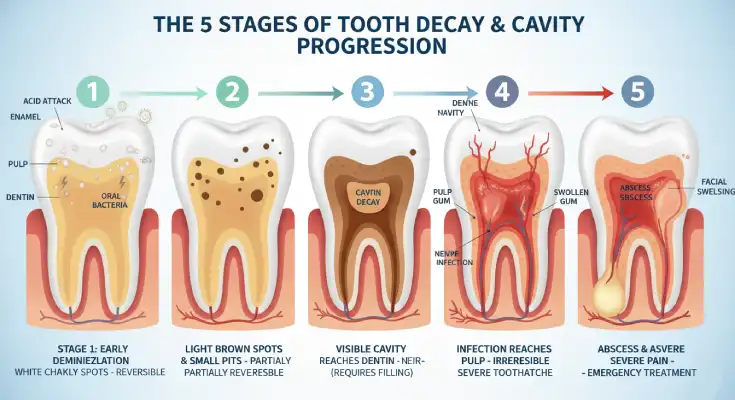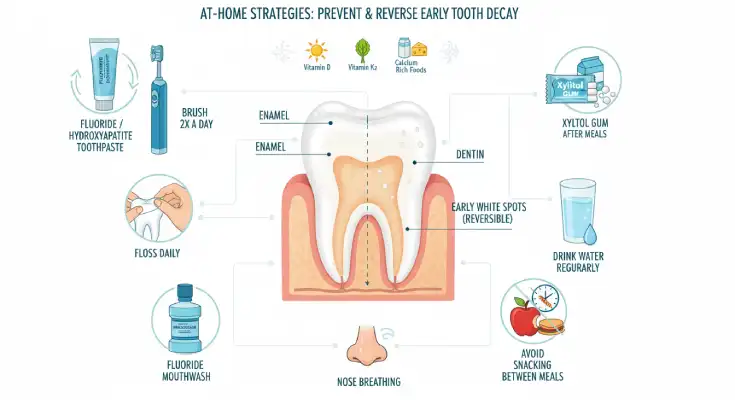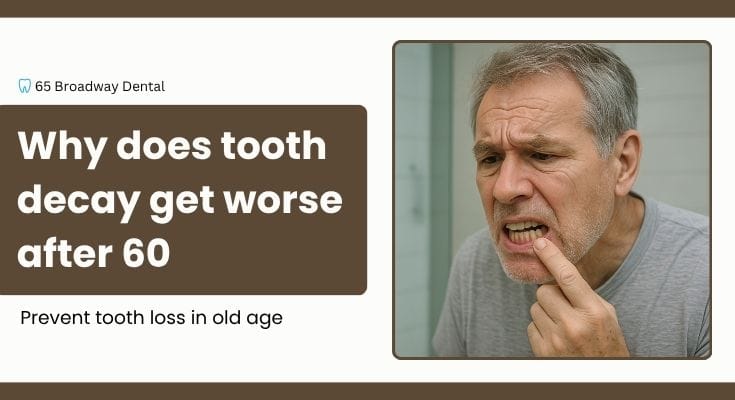The Best Way to Get Rid of Cavities: What Actually Works (Backed by Science)
Cavities are extremely common; almost everyone gets them at some point. But many people are confused about one basic question:
“What is the best way to get rid of cavities | and can they go away on their own?”
Here’s the simple truth:
Yes, early cavities CAN go away.
If the tooth is only starting to lose minerals (white spots or slight enamel weakening), you can still rebuild it naturally.
But once an actual hole forms, it CANNOT heal by itself.
At that point, only a dentist can fix it with a filling, root canal, or other treatments.
So the best way to “get rid of cavities” depends on how early you catch them.
This guide makes everything easy to understand:
- What you can fix at home
- What must be treated by a dentist?
- The fastest and safest science-backed methods
- Simple daily habits to stop cavities for good
Can Cavities Really Go Away?
When oral bacteria create acids that gradually erode your tooth’s enamel, a cavity develops. When this damage first appears, it manifests as tiny white spots, which indicate that the tooth’s surface is still intact but that minerals have been lost.

The cavity can still heal on its own at this stage. Your tooth can regain its strength and restore the minerals it has lost with the correct routine.
However, the damage is irreversible once the enamel truly deteriorates and a real hole appears.
That hole cannot be filled or repaired by your body alone. This stage can only be treated by a dentist using a crown, filling, or other expert procedure.
Quick Breakdown
Cavities that can heal on their own:
- Early white spots
- Surface-level enamel damage
- No visible hole yet
Cavities that cannot heal on their own:
- You can see or feel a hole
- The decay has reached the dentin layer.
- The tooth is extremely sensitive or infected
How Long Does Healing Take?
Reversing an early-stage cavity usually takes:
3–6 months of consistent, daily remineralization care
(brushing with fluoride, reducing sugar, better oral hygiene, etc.)
This is why so many people search topics like:
✓ “How to get rid of cavities fast”
✓ “Can cavities heal themselves?”
✓ “Natural remedies for cavities”
They are attempting to determine whether they require dental care or if they can resolve the issue at home. This explanation clearly lays the groundwork and is in line with what actual users are seeking.
What Causes Cavities?
Cavities develop gradually over time as a result of specific oral health issues that begin to affect your teeth. Plaque, a sticky layer of bacteria that develops naturally on your teeth every day, is where it all starts. These bacteria produce acid as a byproduct of feeding on the leftover sugars in sugary or starchy foods.
This acid-related wear is also similar to tooth erosion at the gum line, which can make teeth even more prone to decay.
Over time, this acid starts dissolving the protective outer layer of your teeth (called enamel). This process is known as demineralization, and if it continues, a cavity eventually forms. Early signs of this mineral loss can appear as white spots on teeth, which is why understanding the best way to get rid of cavities before they progress is so important.
Major Factors That Increase Your Risk
Some things make cavities much more likely, such as:
- Eating sugary snacks or drinks too often
The more frequently you have sugar, the more often your teeth are exposed to acid attacks. - Not brushing or flossing well
When plaque builds up, bacteria have more time to damage your enamel. - Having a dry mouth
By removing food particles and neutralizing acids, saliva shields your teeth. Less saliva means a higher risk. - Genetics
Some people naturally have softer enamel or deeper grooves in their teeth, making them more cavity-prone. - Drinking acidic beverages
Sodas, energy drinks, and even fruit juices can weaken enamel, making it easier for cavities to form.
The 5 Stages of Tooth Decay (What You Can vs. Can’t Fix)
A cavity actually goes through several stages before it becomes painful or serious, and each stage provides a different set of information about what your tooth needs. While later stages necessitate professional dental treatment, some early stages can be fully reversed at home with the correct care.

Knowing these phases enables you to determine what can be fixed, what has already progressed too far, and when you should consult a dentist. To help you understand exactly what’s going on inside your mouth and what you can do about it, here is a straightforward, easy-to-follow breakdown of each stage.
Stage 1: Demineralization (Reversible)
The good news is that you can still treat stage 1 tooth decay at home. The enamel hasn’t cracked yet at this point. Rather, the tooth will have small white or chalky patches. These are early indicators that the enamel is losing minerals.
Since there isn’t yet a visible hole in the tooth, the damage hasn’t spread too far. This stage can be fully reversed with the correct care. Restoring the lost minerals and fortifying the enamel can be achieved by using fluoride toothpaste or products containing hydroxyapatite.
Consider this phase as your tooth’s way of saying, “Hey, something’s wrong, help me before it gets worse!” The tooth can mend itself if you take quick action.
Stage 2: Enamel Decay (Partially Reversible)
The enamel begins to deteriorate more pronouncedly in stage two. At this stage, you may notice small pits developing on the tooth’s surface or the white spots from Stage 1 turning light brown. This indicates that tiny patches of enamel are starting to erode and crumble.
The good news is that if you act fast, you can still slow down or even stop the decay. Fluoride or hydroxyapatite products can be used to partially rebuild the enamel in certain mild cases. However, the tooth finds it more difficult to completely heal itself on its own since the surface is beginning to fracture.
Consider this phase to be the “final warning sign” before a cavity actually develops. You can still prevent the tooth from developing into a complete, irreparable hole with regular care and fewer sugar attacks.
Stage 3: Dentin Cavity (Not Reversible)
At stage three, a real cavity has developed. The decay has now spread to the dentin, the softer layer beneath the enamel, which has now cracked through. This explains why you might notice a real hole in your tooth or experience pain when you bite, sip cold liquids, or consume sweets.
The tooth can no longer repair itself once the decay has reached the dentin. The body is currently unable to replace lost tooth structure due to the extent of the damage. To restore the tooth and prevent the cavity from getting worse, a dentist must remove the decay and apply a filling.
If you’ve noticed a hole or food getting stuck, this hole in my tooth treatment guide explains what to expect and the safest next steps.
Think of this stage as the point of no return. It won’t go away with home remedies, but the good news is that a simple filling can fix the problem and prevent bigger issues later.
Stage 4: Pulp Infection
When decay reaches the pulp, the tooth’s soft interior that houses blood vessels and nerves, it has progressed past the dentin to stage 4. The tooth becomes infected when bacteria get to this point, and the internal nerves begin to react violently.
This is why people often feel deep, throbbing pain that doesn’t go away, or pain that suddenly gets worse at night. You may also feel pressure, swelling, or sensitivity that lingers long after eating or drinking something warm or cold. Advanced decay often irritates the surrounding gums, too. Here’s a helpful guide on gum disease warning signs and treatment.
The tooth cannot heal itself at this point. The only way to save the tooth is to have a root canal, in which the dentist removes the infected pulp and seals the tooth to stop further damage.
Consider Stage 4 to be your tooth’s emergency warning; prompt professional care is necessary to prevent the infection from getting worse.
Stage 5: Abscess (Emergency)
The most severe and agonizing stage of dental decay is stage 5. By now, an abscess, a pocket of pus, has developed as a result of the infection spreading outside the tooth. This frequently results in severe pain, noticeable swelling of the face or gums, and occasionally even fever or an unpleasant taste in the mouth.
You cannot treat an abscess at home. Because the infection can spread to the jaw, neck, or even the bloodstream if treatment is not received, it is regarded as a dental emergency. You require prompt medical attention; depending on the extent of the tooth damage, treatment typically consists of drainage, antibiotics, and either a root canal or extraction.
Think of Stage 5 as the point where your body is loudly warning you: “Get help now.” Quick treatment not only relieves pain but also protects your overall health.
Best Methods for Stages 1–2 (Reversible Early Cavities)
The extent of a cavity determines the best course of treatment. Deeper cavities require professional treatment, but early stages (1–2) can still be healed naturally with the correct routine. The best, scientifically supported techniques for stopping early tooth decay and fortifying your enamel before it becomes a cavity are listed below.
1. High-Fluoride Toothpaste (5,000 ppm)
Regular toothpaste is far weaker than high-fluoride toothpaste. By adhering to weak areas of the enamel and restoring the lost minerals, it benefits your teeth.
Because it provides additional protection for the enamel and helps prevent early decay from getting worse, dentists frequently recommend it to patients who are prone to cavities.
2. In-Office Fluoride Varnish
Your dentist can quickly treat your teeth with fluoride varnish. It has a very high amount of fluoride, which helps rebuild weak enamel much faster than regular toothpaste.
With a 70–90% success rate, this treatment can reverse early decay in both children and adults. Fortifying the enamel inhibits the growth of cavities.
3. Hydroxyapatite Toothpaste (Fluoride Alternative)
Hydroxyapatite toothpaste is extremely safe and effective because it uses the same mineral that makes up your teeth. Like fluoride, it helps rebuild the enamel by filling in small weak spots rather than merely protecting it.
For children, those with sensitive teeth, or anyone who prefers a toothpaste without fluoride, hydroxyapatite is a great alternative because studies have shown that it can remineralize early cavities just as well as fluoride. It repairs early damage to your teeth naturally and is non-toxic and gentle.
4. Xylitol Gum (After Meals)
Chewing xylitol gum after meals is one of the simplest ways to prevent cavities. Because it is a natural sweetener, xylitol helps lower the number of harmful bacteria in your mouth by preventing them from using it as food.
Additionally, chewing gum increases saliva production, which is your mouth’s natural method of removing acids and repairing enamel. Studies indicate that xylitol gum can reduce cavities by 30 to 60% as a result of these two effects.
5. Dietary Correction
Whether cavities develop or not is greatly influenced by what you eat and how frequently you eat. Every time you consume sugar, your oral bacteria produce acids that damage your enamel for 20 to 30 minutes. Therefore, your teeth experience more “acid attacks” the more frequently you snack.
For more clarity on how food choices affect enamel, this list of the best and worst foods for better teeth is extremely helpful.
Reducing the frequency of sugar consumption, not just the amount, is therefore one of the most effective strategies to prevent cavities in their early stages. Reducing frequent snacking also allows your saliva to naturally restore your enamel.
While avoiding acidic beverages like soda, juice, and sports drinks can prevent your enamel from dissolving even more quickly, increasing your intake of calcium and vitamin D can help your body replenish lost minerals.
6. Ozone Therapy (Dentist Only)
Ozone therapy is a painless dental procedure in which your dentist eliminates cavity-causing bacteria using a unique ozone gas. It operates swiftly and can get into small crevices that brushing cannot.
Ozone helps prevent early cavities from worsening and enables the enamel to begin self-repairing by eliminating the dangerous bacteria. Children or anyone looking for a non-invasive treatment option without drilling will find it especially beneficial.
Best Methods for Stages 3–5 (Irreversible Cavities)
Your body cannot naturally repair a cavity once it has become a real hole in your tooth. Only a dentist can repair the tooth and stop the decay at this stage. The good news is that contemporary therapies are quick, secure, and very successful.
Depending on how deep the cavity has gone, the best and most dependable options are listed below, ranging from straightforward fillings to root canals and, in extreme situations, extractions.
1. Dental Fillings
The dentist first extracts all of the tooth’s decayed material when a cavity forms a visible hole. A safe substance, such as metal amalgam or tooth-colored resin, is then used to fill the gap. Fillings are the most popular and dependable treatment for Stage 3 cavities because they are quick, typically painless, and have a 90–95% success rate.
2. Dental Sealants (Preventive)
Sealants are used to prevent cavities rather than to treat them. To prevent food and bacteria from becoming lodged in the deep grooves of your molars, your dentist applies a thin, protective coating. Sealants can lower future cavity risk by up to 80%, making them particularly beneficial for children and teenagers.
3. Root Canal Treatment
You will typically experience excruciating pain when decay reaches the pulp, the tooth’s nerve. The infection cannot heal on its own at this point. A root canal cleans, seals, and removes the diseased tissue from inside the tooth. In order to protect the tooth and restore its full function, a crown is typically placed over it.
4. Extraction (Last Resort)
The safest course of action is to extract a tooth if it is seriously broken, infected, or irreparable. This is typically required when the tooth can no longer be restored or when the abscess has progressed. To maintain the health of your bite and stop teeth from moving after extraction, your dentist might suggest a replacement such as an implant, bridge, or denture.
The Best At-Home Strategies to Prevent and Reverse Early Decay
The early stages of tooth decay can frequently be stopped, and occasionally completely reversed, with the correct daily habits, even though advanced cavities require a dentist. Consistency is crucial. Your enamel is more affected by small daily actions than by a single treatment.

Actually, the best way to prevent cavities begins with easy, research-backed practices that fortify your teeth, shield them from acid erosion, and encourage natural remineralization.
Daily Routine (Evidence-Based):
- Brush twice daily with fluoride or hydroxyapatite
- Floss once daily
- Use a fluoride mouthwash.
- Chew xylitol gumpost-mealss
- Drink water frequently
- Avoid snacking between meals.
- Breathe through your nose, not your mouth
If you’re unsure whether your technique is effective, here’s a simple guide on proper brushing techniques to help avoid plaque buildup and future cavities.
Nutritional Support:
- Vitamin D + K2
- Calcium-rich foods
- Avoid acidic drinks
Natural Remedies: What Works vs. What Doesn’t Work
Oil Pulling (Coconut Oil)
- Lowers harmful bacteria
- Helps with plaque
- Does not reverse cavities
Hydroxyapatite Toothpaste
- Proven to remineralize enamel
- Excellent for sensitive teeth
Vitamin D + K2
- Improves mineral absorption
- Supports enamel strength
How to Know If Your Cavity Is Reversible (Simple Self-Check)
Not sure whether your cavity can heal on its own or if it’s already too far along? Here’s a quick way to figure it out without guessing.
Think of this like a “traffic light” system for your teeth:
🟢 Green Zone: Likely Reversible
If your tooth shows only early signs of weakening, there’s a good chance you can fix it at home with remineralization. You might notice:
- A tiny white or chalky spot on the enamel
- No visible hole, the surface still looks smooth.
- Mild sensitivity that goes away in a few seconds
- Sensitivity only to cold or sweet foods, not constant pain
- No swelling, no throbbing, no pressure pain
If these sound like your symptoms, you’re probably still in the Stage 1–2 cavity zone, which means it can be reversed with fluoride, hydroxyapatite, and diet changes.
🔴 Red Zone: Not Reversible, Needs a Dentist
If your tooth has moved past the early stages, your body can’t rebuild the damage anymore. Warning signs include:
- A visible hole or pit
- Pain that lingers or wakes you up at night
- Food is getting stuck in the same spot regularly.
- Any swelling, bump, pus, or throbbing pain
These symptoms mean the decay has reached deeper layers (Stage 3–5), and only a dentist can stop it from getting worse. If these symptoms sound familiar, you may already be showing signs you need a dental checkup and should see a dentist soon.
Best Solution Based on Your Scenario
Everyone’s situation is a little different, so the best way to get rid of cavities depends on what you’re dealing with. Here’s a quick guide to help you choose the right path:
If you want FAST results:
→ Fluoride varnish + 5,000 ppm high-fluoride toothpaste
This is the quickest way to stop early decay and rebuild enamel.
If you prefer natural solutions:
→ Hydroxyapatite toothpaste + xylitol gum + vitamin D
These work together to strengthen enamel, support minerals, and reduce cavity-causing bacteria, without fluoride.
If you want to avoid drilling:
→ Early detection + daily remineralization routine
If your cavity is still in Stage 1–2, consistent care can stop it before a filling is needed.
If you already have a hole:
→ A dental filling is the only solution
Once a physical hole forms, no natural method can close it. Only a dentist can repair it.
For kids:
→ Sealants + fluoride varnish every 6 months
These two steps dramatically reduce cavity risk and protect molars during growing years.
For dry mouth:
Dry mouth increases cavity risk, so moisture support is essential.
Use:
- Saliva substitutes
- Sugar-free lozenges or xylitol mints
- Plenty of water
- Alcohol-free mouthwash only
If you frequently wake up with a dry mouth or feel like you don’t produce enough saliva, it’s important to understand the underlying cause. This guide on dry mouth and natural solutions can help.
FAQs
1. Can cavities be reversed?
Yes, but only when the damage is limited to early enamel weakening (white spots or surface-level demineralization). Once a visible hole forms, the cavity is no longer reversible and requires dental treatment.
2. How long does it take to reverse a cavity?
Most early cavities improve within 3–6 months when you consistently use fluoride or hydroxyapatite toothpaste, reduce sugar, and follow a strong oral hygiene routine. Reversal is gradual, not instant.
3. Are natural remedies enough?
Natural methods can support prevention and early enamel repair, but they cannot fix a cavity that already has a hole. Once dentin is exposed, only a dentist can stop the decay.
4. Can hydroxyapatite toothpaste fix cavities?
Hydroxyapatite can rebuild early enamel damage and is clinically shown to be as effective as fluoride for early remineralization. However, it cannot repair an actual cavity hole.
5. Can I brush a cavity?
Yes. You should keep brushing gently around the area. Brushing won’t heal a cavity, but it prevents bacteria from making it worse and slows the progression until you see a dentist.
6. What happens if a cavity is left untreated?
A small cavity gradually deepens into the dentin, reaches the nerve, causes infection, leads to an abscess, and eventually results in tooth loss. In severe cases, the infection can spread to the jaw or bloodstream.

Dr. Alexander Heifitz (Author)
Dr. Alexander Heifitz is the founder of 65 Broadway Dental in NYC, where he combines advanced dental expertise with a patient-first approach. He specializes in cosmetic and restorative treatments such as dental implants, veneers, Invisalign, and smile makeovers, helping New Yorkers achieve both oral health and confidence.
Booking An Appointment
Looking for a reliable dentist in Downtown NYC? Whether you need a routine cleaning, urgent care, or a full smile transformation — we’ve got you covered. We accept most PPO insurance plans and offer flexible scheduling.
+1 (212) 430-3888
Call for appointment
Walk-ins Welcome / Same-Day Appointments Available

Related Blogs

Factors That Accelerate Tooth Decay in People Over 60
Tooth decay often worsens after 60 due to dry mouth, gum recession, medications, poor diet, and reduced saliva flow, increasing cavity risk.
Read More
The Hidden Sugar in Healthy Kids’ Food
Is your child struggling with cavities or low energy? Discover which kids’ foods contain the highest sugar and how to make healthier choices.
Read More